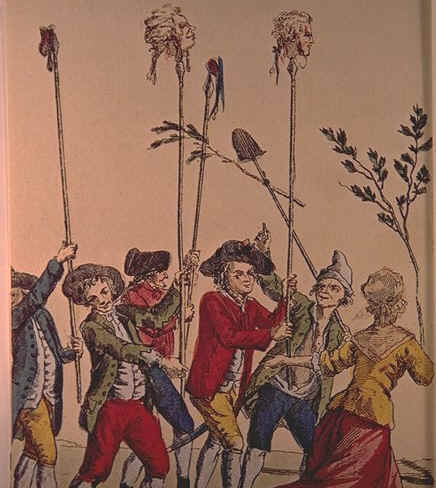The Reign of Terror

Rioters with heads on pikes. (Public Domain photo. Info can be found here)
After the death of Marat there was an attempted coup d’etat by General Dumouriez, which would cause the Jacobins take power and push for another round of executions of anti-revolutionaries. The Jacobins would create a small group of leaders to root out the anti-revolutionaries called the Committee of Public Safety (1793). This group would essentially run France during this time, since they could execute anyone who they disliked. They would start by arresting 29 Girondist leaders and kick the popular Georges Danton out of leadership. After this they spent spies to watch all officers and would execute any officer who didn’t handle himself the way they wanted. The Committee would often refer to itself as the “Wrath of the people” and try to instill terror into the hearts of anyone who went against the Revolution.
The violent repression would soon include the regular people of France, as the group sent thousands of spies to monitor all public conversation and execute those who didn’t speak correctly of the revolution. The slightest misspoken word or lack of enthusiasm could lead to execution, and with all of this drama many people simply falsely accused people they disliked. The Committee would also become the court system for executions in which they required only 1 person to accuse someone and no counter witnesses were allowed for defense.
The guillotine became known as the “National Razor” and was used so often that it would become its own symbol of the revolution. A total of 16,594 people were executed by guillotine and another 25,000-40,000 were
executed across France in other ways. The majority of those executed were peasants who were accused of evading the draft, desertion or rebellion.
On top of the executions, the Committee would make a number of major decisions during their time in power. They would send the military in to take crops from farmers in order to help with the lack of food during the crop failures. This may have helped a bit in Paris, but it left the farmers in the surrounding communities to starve (or close to it). The French Constitution of 1793 would be a radically liberal constitution created by the Committee that would make a major impact of France, despite not being used for very long. It would give universal male suffrage (voting) and abolished slavery in the colonies, which would go into effect in 1794 but be retracted in 1802.
The open ambition to inspire revolutions in other countries would continue to create enemies for France. The Committee would create the first draft in history (at the request of member/general Lazare Carnot) to help the military with these enemies and, under it, the military would boom from 180,000 men to over 1 million in the first year. They ended up with so many people that they were forced to give out some really out of date equipment (like pikes). Unfortunately for the French, this increase in French troops simply caused more countries to join coalitions against them (Spain, Portugal, Austria, Holland, Great Britain, Prussia, etc).
While the French were clear they wanted to export the Revolution, they made a number of mistakes during these battles that would hurt them significantly in this regard. They would start to have a reputation in some areas for killing women, children, and even animals when they felt like it. Some of the worst stories involved tying large groups of people together and drowning them in a river. This may not be abnormal for wars before them, it didn’t help inspire other people to want to start a revolution based on their example.
